| |
|
|
SPOTTED SPREADWING
Lestes congener
|
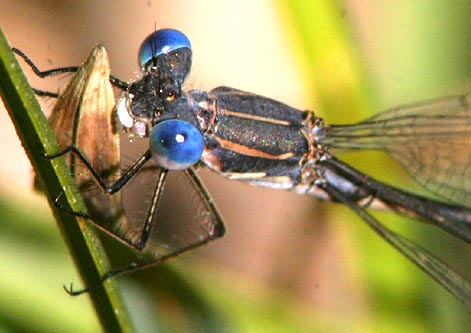 |
photo (above) 14
Oct 2006 Arroyo Seco Lakes
|
Spotted Spreadwing is a small, dark
spreadwing that appears late
in the yearly cycle. Males (above & below) have bright blue eyes,
blackish
upper surface to body, and thin tan stripes on the thorax. They prefer
the edges of quiet reedy ponds.

photo (above &
below) 14 Oct 2006 Arroyo
Seco Lakes
|
| Spotted Spreadwing is similar to Black Spreadwing
— an earlier flying
species using similar habitats — but Spotted is smaller and less
stocky,
and males are separable by their appendages. The paraprocts are very
short,
as can be seen in the two photos below. Compare those to Black
Spreadwing [and see also Manolis 2003].
|
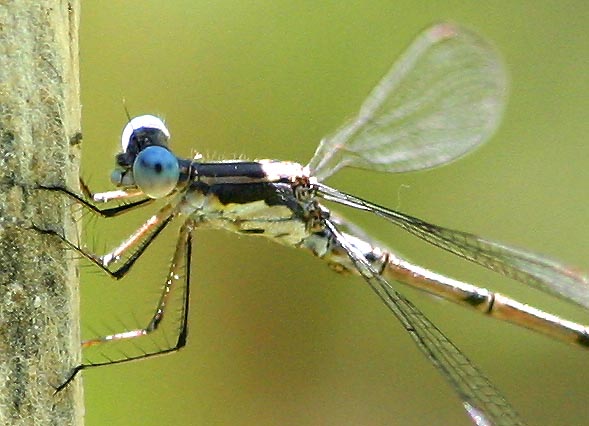 Females
are tan-and-white (right & below). The species is named for a set
of
small black spots on the underside of the thorax. Both sexes have these
spots, and they are visible in these pics of females. Apparently Black
Spreadwing can sometimes also have similar spots (Manolis 2003), so
looking
at appendages is important. Note also the brown pterostigma on these
females. Females
are tan-and-white (right & below). The species is named for a set
of
small black spots on the underside of the thorax. Both sexes have these
spots, and they are visible in these pics of females. Apparently Black
Spreadwing can sometimes also have similar spots (Manolis 2003), so
looking
at appendages is important. Note also the brown pterostigma on these
females. |
|
photo (above) 5
Aug 2006 Arroyo Seco Lakes
photo (below) 24 July 2006 Arroyo
Seco Lakes
|
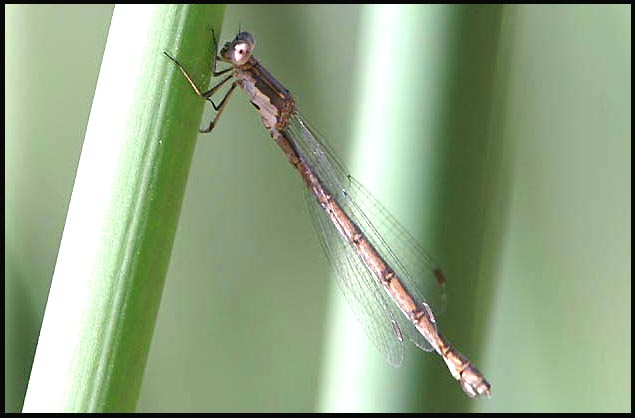
|
 Females
(left) can be separated from Black Spreadwing by the relative length of
the ovipositor and 7th abdominal segment (below). On Spotted, the 7th
segment
is longer than the ovipositor. On Black, the ovipositor is the same as,
or longer than, the 7th segment Females
(left) can be separated from Black Spreadwing by the relative length of
the ovipositor and 7th abdominal segment (below). On Spotted, the 7th
segment
is longer than the ovipositor. On Black, the ovipositor is the same as,
or longer than, the 7th segment
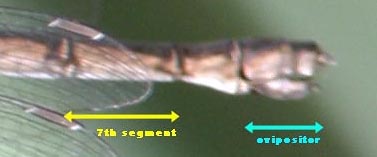
|
Spotted Spreadwing can be even more complicated,
though, because old
males can have so much pruinescense that the thorax becomes pale
silvery-purple.
When I encountered these in the high Sierra (photo below from Alpine
County),
it certainly confused me because the odes were so pale. I haven't seen
any like this in MTY yet.

Photo (above) 14
Aug 2006 Indian Valley
Reservoir ALP
|
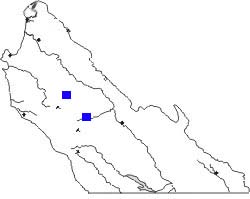 The
map shows the currently known distribution of Spotted Spreadwing in
MTY,
just two locations: Hastings Nat. Hist. Reservation in upper
Carmel
Valley (4 specimens 1938-1942) and Arroyo Seco Lakes (various
observations
July-Oct). The species is likely widespread in the county, and should
be
looked for in reedy ponds anywhere. The
map shows the currently known distribution of Spotted Spreadwing in
MTY,
just two locations: Hastings Nat. Hist. Reservation in upper
Carmel
Valley (4 specimens 1938-1942) and Arroyo Seco Lakes (various
observations
July-Oct). The species is likely widespread in the county, and should
be
looked for in reedy ponds anywhere.
The MTY date span is 26 May-14 Oct. This is
pretty much the date span
known from elsewhere in California, although there are some records
elsewhere
into November.
|
|
|
Literature cited:
- Manolis, T. 2003. Dragonflies and Damselflies of
California. Univ. of
Calif.
Press, Berkeley.
Web resources:
Major identification web sites with much information on California
odes include:
For sites with excellent photos to compare for identification or to
simply
enjoy, see:
Many of these sites have links to other useful pages. Kathy Biggs's
site
is particularly useful in her selection of links. |
|
All photos © Don Roberson 2007
TOP
|
|
|
|
|
|
|
|
|
